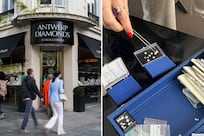As I walked down Redchurch Street in London's Shoreditch in brilliant sunshine last week, a fashion student in town for Graduate Fashion Week passed by me wearing the quintessential uniform of this summer: draped toga T-shirt, grey leggings, pointy shouldered jacket, skinny scarf... and clogs. Dodging the heat of the city, I bounced into shops for a quick blast of AC only to discover that even the furniture stores were selling clogs.
Nearby, on Hoxton's quieter backstreets, the endless clip clopping of wooden sole on York stone pavement provided a sort of white noise backdrop to the hum of distant traffic. I know the eco warrior/green vibe is cool right now, but clogs? What stone did they crawl out from? I hadn't seen them for a decade until Thursday, when they thundered down the runway on the feet of models at the London College of Fashion graduate show.
I always make a point of going to Graduate Fashion Week. It's a great place to spot new trends, extraordinary creations and concepts and talented future stars like Weston Gordon, a Central St Martins undergrad whose catwalk featured an evening gown with a blown glass bodice. It's not just what's on the runway but who is behind it making last-minute adjustments to their final collections that is interesting. Looking at what the next generation of fashion and textile students are wearing can be just as insightful as their designs.
So what were the catwalk trends? This depressing recession means now is not the time to do an underwhelming collection of little black dresses. There was hardly any black. A pretty palette with arresting combinations like shrimp and jade or verdigris and red provided mostly upbeat, aesthetically pleasing outfits. Hi-tech fabrics and state-of-the-art techniques like laser cutting and digital prints were emphasised.
Intriguing accessories included a handbag fashioned from a clipboard and giant wooden-framed sunglasses. And there were clogs - in every size, fabric and heel height. There were to-the-knee bootee clogs; clogs with dog collar straps that snaked around the leg. Some had piercings bored through the soles and jewellery threaded through. There was even a collection that featured pairs swathed in fabric, presumably to minimise the clomp factor.
This time around they aren't being teamed with the item of clothing once thought to be their natural-born twin: the maxi. Many students put them with skinny tomboy jeans rolled to the ankle or leggings paired with mini skirts and tailored jackets. Last season's vertiginous high heel platforms were conspicuously absent, which brought in an entirely new mood. On and off the catwalk, clogs are the shoe of choice. I'm reliably informed that by September, clogs will have replaced pumps, gladiator sandals and espadrilles as the shoe of the day - although perhaps not the evening. I'm still getting my head around this.
My mother wore clogs in the 1970s. We used to get complaints from the woman in the apartment below, who used to beat on her ceiling with a wooden stick when my mother (a professionally trained tap dancer) would walk around in them. The clogs tipped to be huge this time around are by the US brand No 6. Traditional styles from Beavers, the Danish firm Sanita and Cape Clogs from Sweden are also set to do well. The secret is to not wear them with anything remotely folkloric, frumpy or hippie looking. So no dirndl skirts, frogging or coloured stripy tights.
Cape Clogs have recently undergone a makeover; this summer's styles include black patent with delicious shiny black wood heels that certainly bring out my inner teenager. At my senior school, clogs were frowned upon, so naturally I wore them whenever I could. I customised a navy leather pair I bought on holiday in France with Jackson Pollock-style paint splodges, and particularly enjoyed clomping up the marble stairwell near the school staff room.
Then one day I got my comeuppance and fell off my clogs. It really hurt. A year later it still really hurt. The fall effectively ruined any chance of me wearing 8cm Jimmy Choos. I can still only walk five paces in killer heels before I keel over in pain. There is nothing to stop me from wearing flat clogs, though, especially if it means I can join in - visibly and audibly - with such a hot trend. That's the thing about clogs. They don't "do" quiet.




